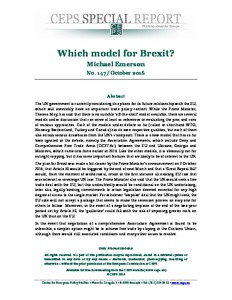Which model for Brexit?
"The UK government is currently considering its options for its future relationship with the EU, which will inevitably have an important trade policy content. While the Prime Minister, Theresa May, has said that there is no suitable ‘off-the-shelf’ model available, there are several models unde...
| Main Author: | |
|---|---|
| Institution: | ETUI-European Trade Union Institute |
| Format: | TEXT |
| Language: | English |
| Published: |
Brussels
2016
CEPS |
| Subjects: | |
| Online Access: | https://www.labourline.org/KENTIKA-927312474559-Which-model-for-Brexit?.htm |
| Summary: | "The UK government is currently considering its options for its future relationship with the EU, which will inevitably have an important trade policy content. While the Prime Minister, Theresa May, has said that there is no suitable ‘off-the-shelf’ model available, there are several models under discussion that can at least serve as references in evaluating the pros and cons of various approaches. Each of the models under debate so far (called in shorthand WTO, Norway, Switzerland, Turkey and Canada) has its own respective qualities, but each of them also entails serious drawbacks from a UK standpoint. There is a new model that has so far been ignored in the debate, namely the Association Agreements, which include Deep and Comprehensive Free Trade Areas (DCFTAs), between the EU and Ukraine, Georgia and Moldova, which came into force earlier in 2016. Like the other models, it is obviously not for outright copying, but it has some important features that are likely to be of interest to the UK.
The plan for Brexit was made a bit clearer by the Prime Minister’s announcement on 2 October 2016, that Article 50 would be triggered by the end of next March and that a ‘Great Repeal Bill’ would, from the moment of withdrawal, retain in the first instance all existing EU law that was relevant as sovereign UK law. The Prime Minister also said that the UK would seek a free trade deal with the EU, but this undoubtedly would be conditional on the UK undertaking, inter alia, legally binding commitments to retain legislation deemed essential for any high degree of access to the single market. For whatever ‘bespoke’ deal that the UK might seek, the EU side will not accept a package that seems to make the secession process an easy one for others to follow. Moreover, in the event of a negotiating impasse at the end of the two-year period set by Article 50, the ‘guillotine’ could fall with the risk of imposing greater costs on the UK than on the EU.
In the event that negotiation of a comprehensive Association Agreement were found to be infeasible, a simpler option might be to achieve free trade by staying in the Customs Union, although there would still associated conditions and many other issues to resolve." |
|---|---|
| Physical Description: | 17 p. Digital |

